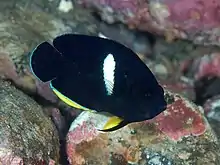Centropyge tibicen
Centropyge tibicen, the keyhole angelfish, black angelfish, whitespot angelfish or puller angelfish, is a species of marine ray-finned fish, a marine angelfish belonging to the family Pomacanthidae. It is found in the Indo-Pacific region.
| Centropyge tibicen | |
|---|---|
 | |
| Scientific classification | |
| Domain: | Eukaryota |
| Kingdom: | Animalia |
| Phylum: | Chordata |
| Class: | Actinopterygii |
| Order: | Perciformes |
| Family: | Pomacanthidae |
| Genus: | Centropyge |
| Species: | C. tibicen |
| Binomial name | |
| Centropyge tibicen (Cuvier, 1831) | |
| Synonyms[2] | |
|
Holacanthus tibicen Cuvier, 1831 | |
Description
Centropyge tibicen is mainly black in colour, the adults have an elongated vertical black blotch in the centre of the upper flanks. Smaller fish are mainly black with a white vertical bar which changes to a central blotch and becomes highly variable in form and extent. The dorsal and anal fins have a blue line just below their margin. Much of the pelvic and the front part of the anal fin are yellow. The caudal fin has a blue line which is positioned submarginally. The dorsal fin contains 14 spines and 15-16 soft rays while the anal fin has 3 spines and 16-17 soft rays. This species attains a maximum total length of 19 centimetres (7.5 in).[2]
Distribution
Centropyge tibicen Is found in the Indo-Pacific region. It occurs from northwestern coast of Australia and Christmas Island east through the Indo-Australian Archipelago to Vanuatu and Tonga in the east. They extend as far north as southern Japan and Taiwan and to Lord Howe Island.[1]
Habitat and biology
Centropyge tibicen is found at depths between 4 and 35 metres (13 and 115 ft).[1] It is an uncommon species of areas where there is a mixture of coral and rubble on both lagoon and seaward reefs. It is herbivorous and algae dominates its diet. It lives in harems of 3-7 fishes.[2] This species is able to change sex from female to male, when there is no male in a harem, one of the females changes sex.[3]
Systematics
Centropyge tibicen was first formally described as Holocanthus tibicen in 1831 by the French anatomist Georges Cuvier (1769-1832).[4] The specific name tibicen means “trumpeter”, this is thought to be alluding to the name given to this species by the Dutch naturalist François Valentijn (1666-1727) in 1726, Japonfche Trompetter.[5] When Johann Jakob Kaup described the genus Centropyge in 1860 he named Cuvier’s H. tibicen as the type species.[6] As the type species it is placed in the subgenus Centropyge.[5]
Utilisation
Centropyge tibicen is frequently found in the aquarium trade.[1]
References
- Pyle, R.; Myers, R.F. (2010). "Centropyge tibicen". IUCN Red List of Threatened Species. 2010: e.T165901A6161055. doi:10.2305/IUCN.UK.2010-4.RLTS.T165901A6161055.en. Retrieved 20 November 2021.
- Froese, Rainer; Pauly, Daniel (eds.) (2019). "Centropyge tibicen" in FishBase. December 2019 version.
- "Centropyge tibicen". reefapp,net. Retrieved 1 February 2021.
- Eschmeyer, William N.; Fricke, Ron & van der Laan, Richard (eds.). "Species in the genus Centropyge". Catalog of Fishes. California Academy of Sciences. Retrieved 1 February 2021.
- Christopher Scharpf & Kenneth J. Lazara (21 July 2020). "Order ACANTHURIFORMES (part 1): Families LOBOTIDAE, POMACANTHIDAE, DREPANEIDAE and CHAETODONTIDAE". The ETYFish Project Fish Name Etymology Database. Christopher Scharpf and Kenneth J. Lazara. Retrieved 1 February 2021.
- Eschmeyer, William N.; Fricke, Ron & van der Laan, Richard (eds.). "Genera in the family Pomacanthidae". Catalog of Fishes. California Academy of Sciences. Retrieved 1 February 2021.
External links
- Photos of Centropyge tibicen on Sealife Collection
